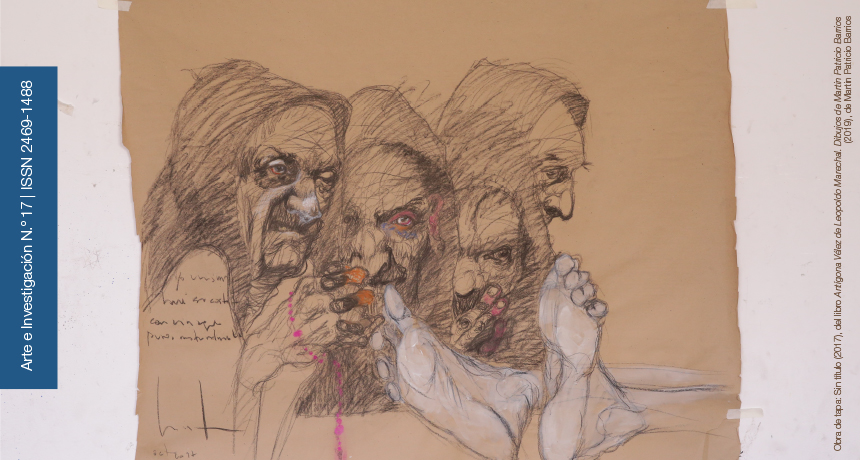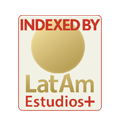Epistemic Dimension of Image. Contributions to Teaching Art at University
DOI:
https://doi.org/10.24215/24691488e051Keywords:
Art, knowledge, imageAbstract
This research aims to make a processual study that will allow to systematize the artistic experience, in the context of perspective, according to the characteristics of artistic process and current paradigms of knowledge concept. The aim is to achieve an analysis of the epistemic dimension of the image from a thematic selection of cases, which will make it possible to examine images of different spaces and historical moments. These cases will not be studied chronologically but from a complex, processual, relational and situational approach to art, associated with contributions of different disciplines (Epistemology of Art, Visual Studies, History of Art, Aesthetics and Theory of Art).Downloads
References
Bourriaud, N. (2006). Estética relacional. Ciudad Autónoma de Buenos Aires, Argentina: Adriana Hidalgo Editora.
Brea, J. L. (2003). El tercer umbral - Estatuto de las prácticas artísticas en la era del capitalismo cultural. Murcia, España: Cendeac.
Casacuberta, D. (2003). Creación colectiva. En internet el creador es el público. Barcelona, España: Gedisa.
Castro, S. (2005). En defensa del cognitivismo en el arte. Revista de Filosofía, 30(1), 147-164. Recuperado de https://revistas.ucm.es/index.php/RESF/article/view/RESF0505120147A
Catalá, J. (2005). La imagen compleja. La fenomenología de las imágenes en la era de la cultura visual. Barcelona, España: Universidad de Barcelona.
Claramonte Arrufat, J. (22 de noviembre de 2008). Del arte de concepto al arte de contexto. Estética y Teoría del arte [Entrada de blog]. Recuperado de https://jordiclaramonte.blogspot.com/search?q=concepto
Deleuze, G. y Guattari, F. (1976). Rizoma. Valencia, España: Pre-textos.
Dewey, J. (2008). El arte como experiencia. Ciudad Autónoma de Buenos Aires, Argentina: Paidós.
Fernández Polanco, A. (2013). Escribir desde el montaje. Otra forma de exponer. En S. Blasco (Ed.), Investigación artística y universidad: materiales para un debate (pp. 105-115). Madrid, España: Asimétricas.
Foucault, M. (1980). Las palabras y las cosas. Ciudad de México, México: Siglo Veintiuno.
Gadamer, H. G. (1991). Verdad y método. Fundamentos de una hermenéutica filosófica. Salamanca, España: Sígueme.
García, S. y Belén, P. (2013). Aportes epistemológicos y metodológicos de la investigación artística. Fundamentos, conceptos y diseño de proyectos. Saarbrücken, Alemania: Editorial académica española.
Gardner, H. (2005). Arte, mente y cerebro. Una aproximación cognitiva a la creatividad. Ciudad Autónoma de Buenos Aires, Argentina: Paidós.
Gaut, B. (2003). Art and Knowledge. En J. Levinson (Ed.), The Oxford Handbook of Aesthetics (pp. 439-441). Oxford, Inglaterra: Oxford University Press.
Goodman, N. (1976). Los lenguajes del arte. Barcelona, España: Seix Barral.
Goodman, N. (1990). Maneras de hacer mundos. Madrid, España: Visor.
Heidegger, M. (2003). Caminos de bosque. Madrid, España: Alianza.
Jay, M. (2009). Cantos de experiencia: variaciones modernas sobre un tema universal. Ciudad Autónoma de Buenos Aires, Argentina: Paidós.
Kant, I. (1992). Crítica de la facultad de juzgar. Caracas, Venezuela: Monte Ávila.
Maldonado, C. (2005). Heurística y producción de conocimiento nuevo en la perspectiva CTS. En I. Hernández García (Comp.), Estética, Ciencia y Tecnología. Creaciones electrónicas y numéricas (pp. 47-70). Bogotá, Colombia: Pontificia Universidad Javeriana.
Maturana, H. y Varela, F. (1990). El árbol del conocimiento. Santiago, Chile: Editorial Universitaria.
Merleau-Ponty, M. (1977). El ojo y el espíritu. Ciudad Autónoma de Buenos Aires, Argentina: Paidós.
Morin, E. (1981). El Método. La naturaleza de la naturaleza. Madrid, España: Cátedra.
Najmanovich, D. (2005). Estética del pensamiento complejo. Andamios, 1(2), 19-42. Recuperado de http://www.scielo.org.mx/pdf/anda/v1n2/v1n2a2.pdf
Rorty, R. (1989). La filosofía como espejo de la naturaleza. Madrid, España: Cátedra.
Vigo, E. A. (1971-1975). Hexágono ’71. Recuperado de http://caevediciones.blogspot.com/p/hexagono-71.html
Downloads
Published
How to Cite
Issue
Section
License
The acceptance of the manuscript by the magazine means the non-exclusive cession of the property rights of the authors in favour of the editor, who allows the reuse, after publication (post print), under a license Attribution-NonCommercial-NoDerivatives 4.0 International. According to these terms, the material can be copied and redistributed by any means or in any format as long as a) the author and original source of the publication are quoted (magazine and URL of the work), access to the license is provided and whether changes have been made is mentioned; and b) the material is not used for commercial purposes.
The cession of non-exclusive rights means that after the publication (post print) in Arte e Investigación the authors can publish their work in any language, means and format; in such cases it must be mentioned that the material was originally published in this magazine. Such cession also means the authorization of the authors for the work to be collected by SEDICI, the institutional archive of the National University of La Plata, and to be spread in the databases that the editorial team considers appropriate to increase the visibility of the publication and its authors.
Moreover, the magazine encourages the authors to deposit their productions in other institutional and thematic archives under the principle that offering the society the scientific and academic production without any restrictions contributes to a greater exchange of the global knowledge.


































